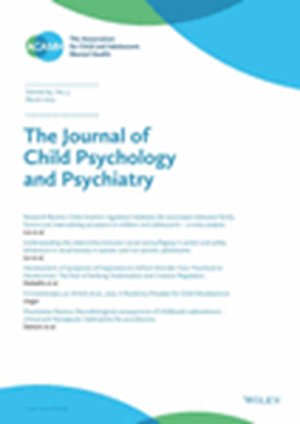Examining the association between cognitive ability and emotional problems across childhood using a genetically informative design: could there be a causal relationship?
IF 6.5
1区 医学
Q1 PSYCHIATRY
引用次数: 0
Abstract
BACKGROUND Emotional problems co-occur with difficulties in verbal and nonverbal cognitive ability, yet the pathways underlying their association remain poorly understood: It is unclear whether effects may be causal, and to what extent they may run from cognition to emotion, or vice versa. METHODS Our preregistered analyses included 5,124 twin pairs from the Twins Early Development Study (TEDS). At ages 7, 9 and 12, emotional problems were assessed through the strengths and difficulties questionnaire, and cognition was assessed using task-based measures. Cross-lagged models examined the influence of cognition and subdomains of verbal and nonverbal abilities on emotional problems and vice versa, across development. Genetic cross-lagged models examined the effect of cognition on emotional problems and vice versa, after controlling for shared genetic and environmental influence. RESULTS Cross-lagged paths in both directions were observed between cognitive ability and emotional problems (from -0.11 to -0.05). Cross-lagged associations that persisted after accounting for common genetic and environmental influences were between nonverbal ability and emotional problems. Higher emotional problems at age 7 predicted lower nonverbal ability at age 9, with 22% of the phenotypic association remaining. This, in turn, predicted greater emotional problems at age 12, with 13% of the association remaining. CONCLUSIONS Genetic and environmental factors accounted for a large proportion of the cross-lagged associations. Emotional problems in early childhood could result in a cascade effect, leading to lower nonverbal cognition in middle childhood, which increases the risk of emotional problems in late childhood. These findings highlight the importance of age- and domain-specific interventions.使用遗传信息设计检查儿童时期认知能力和情绪问题之间的关系:是否存在因果关系?
情感问题与语言和非语言认知能力的困难同时发生,但它们之间联系的途径仍然知之甚少:目前尚不清楚影响是否可能是因果关系,以及它们从认知到情感的程度,或反之亦然。方法我们的预注册分析包括来自双胞胎早期发育研究(TEDS)的5124对双胞胎。在7岁、9岁和12岁时,通过优势和困难问卷评估情绪问题,使用任务型量表评估认知问题。交叉滞后模型考察了认知和语言和非语言能力的子领域对情绪问题的影响,反之亦然。在控制了共同的遗传和环境影响后,遗传交叉滞后模型检验了认知对情绪问题的影响,反之亦然。结果认知能力与情绪问题呈双向交叉滞后关系(-0.11 ~ -0.05)。在考虑了共同的遗传和环境影响后,非语言能力和情绪问题之间的交叉滞后关联仍然存在。7岁时较高的情绪问题预示着9岁时较低的非语言能力,剩下22%的表型关联。反过来,这预示着12岁时更大的情绪问题,其中13%的关联仍然存在。结论遗传和环境因素在交叉滞后关联中占很大比例。儿童早期的情绪问题可能会导致级联效应,导致儿童中期的非语言认知能力下降,这增加了儿童后期出现情绪问题的风险。这些发现强调了针对年龄和领域的干预措施的重要性。
本文章由计算机程序翻译,如有差异,请以英文原文为准。
求助全文
约1分钟内获得全文
求助全文
来源期刊
CiteScore
13.80
自引率
5.30%
发文量
169
审稿时长
1 months
期刊介绍:
The Journal of Child Psychology and Psychiatry (JCPP) is a highly regarded international publication that focuses on the fields of child and adolescent psychology and psychiatry. It is recognized for publishing top-tier, clinically relevant research across various disciplines related to these areas. JCPP has a broad global readership and covers a diverse range of topics, including:
Epidemiology: Studies on the prevalence and distribution of mental health issues in children and adolescents.
Diagnosis: Research on the identification and classification of childhood disorders.
Treatments: Psychotherapeutic and psychopharmacological interventions for child and adolescent mental health.
Behavior and Cognition: Studies on the behavioral and cognitive aspects of childhood disorders.
Neuroscience and Neurobiology: Research on the neural and biological underpinnings of child mental health.
Genetics: Genetic factors contributing to the development of childhood disorders.
JCPP serves as a platform for integrating empirical research, clinical studies, and high-quality reviews from diverse perspectives, theoretical viewpoints, and disciplines. This interdisciplinary approach is a key feature of the journal, as it fosters a comprehensive understanding of child and adolescent mental health.
The Journal of Child Psychology and Psychiatry is published 12 times a year and is affiliated with the Association for Child and Adolescent Mental Health (ACAMH), which supports the journal's mission to advance knowledge and practice in the field of child and adolescent mental health.

 求助内容:
求助内容: 应助结果提醒方式:
应助结果提醒方式:


